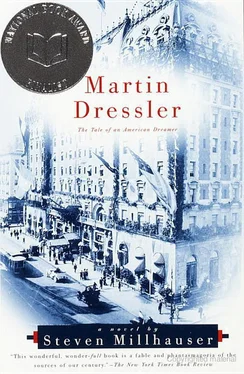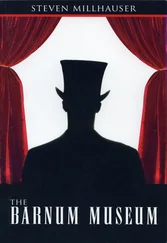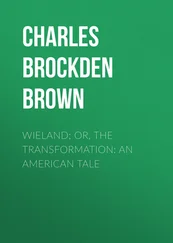Steven Millhauser - Martin Dressler - The Tale of an American Dreamer
Здесь есть возможность читать онлайн «Steven Millhauser - Martin Dressler - The Tale of an American Dreamer» весь текст электронной книги совершенно бесплатно (целиком полную версию без сокращений). В некоторых случаях можно слушать аудио, скачать через торрент в формате fb2 и присутствует краткое содержание. Год выпуска: 1997, ISBN: 1997, Издательство: Vintage, Жанр: Современная проза, на английском языке. Описание произведения, (предисловие) а так же отзывы посетителей доступны на портале библиотеки ЛибКат.
- Название:Martin Dressler: The Tale of an American Dreamer
- Автор:
- Издательство:Vintage
- Жанр:
- Год:1997
- ISBN:1439500487
- Рейтинг книги:4 / 5. Голосов: 1
-
Избранное:Добавить в избранное
- Отзывы:
-
Ваша оценка:
- 80
- 1
- 2
- 3
- 4
- 5
Martin Dressler: The Tale of an American Dreamer: краткое содержание, описание и аннотация
Предлагаем к чтению аннотацию, описание, краткое содержание или предисловие (зависит от того, что написал сам автор книги «Martin Dressler: The Tale of an American Dreamer»). Если вы не нашли необходимую информацию о книге — напишите в комментариях, мы постараемся отыскать её.
Martin Dressler: The Tale of an American Dreamer — читать онлайн бесплатно полную книгу (весь текст) целиком
Ниже представлен текст книги, разбитый по страницам. Система сохранения места последней прочитанной страницы, позволяет с удобством читать онлайн бесплатно книгу «Martin Dressler: The Tale of an American Dreamer», без необходимости каждый раз заново искать на чём Вы остановились. Поставьте закладку, и сможете в любой момент перейти на страницу, на которой закончили чтение.
Интервал:
Закладка:
Other floors, it was noted, were not without their peculiarities, for on each floor of apartments was a suite of Culture Rooms, devoted to a wide variety of artistic, scientific, and historical subjects. There were reproductions of masterpieces of American and European painting by the renowned copyist Winthrop Owens, each in its precisely replicated frame; an orrery composed of transparent glass globes, illuminated from within and suspended from a starry ceiling; collections of armor, of fossils, of Egyptian artifacts; crabs and fishes in great glass aquaria; a display of Edison inventions, including the wax-cylinder phonograph, the Kinetoscope cabinet with its eyepiece and lens and its motor-turned strip of film, the carbon-filament incandescent lamp, the fluoroscope, the quadruplex telegraph, and the electric pen with its egg-sized attached motor, all surrounding a table at which sat a lifesized waxwork of The Wizard of Menlo Park, modeled after the famous photograph of the inventor leaning his head against his half-closed hand as he sat beside his phonograph at 5 P.M. on June 16, 1888, after five days without sleep; a moving panorama called A Steamboat Journey up the Hudson and Along the Erie Canal to Niagara , accompanied by sound effects such as booming thunder and steamboat whistles; and a twenty-foot wooden model of Manhattan in 1850, including not only every house, farm, hotel, church, commercial building, pleasure garden, and wharf, not only automated horsecars and omnibuses running up and down the avenues, but more than 10,000 miniature people in individual dress. These displays, designed by artists and stage designers in collaboration with members of the American Museum of Natural History and the Metropolitan Museum of Art, were intended to provide hotel guests with a wide range of culture, without the considerable inconvenience of city traffic.
Such features were described, attacked, and praised in newspaper reviews that Martin read carefully and with a certain impatience, for it seemed to him that the writers were leaving something out, something that had nothing to do with hotel architecture or the suitability of cultural attractions to a family hotel, and it was not until a long article appeared in the Architectural Record , sharply attacking the New Dressler, that Martin felt his deeper intentions had been understood.
For the writer, after praising certain features of the design, such as the pleasing division of the massive and massively ornamented facade into three parts marked by string courses, and acknowledging certain technological advances, such as the steam-powered vacuum cleaning system and the filtered cool-air system, in which air was forced by electric blowers over iron coils submerged in icy saltwater, turned his attention to the idea represented by alien elements drawn from such modern institutions as the museum, the department store, and the world’s fair. He noted the large number of theatrical elements — the actors in the twelfth-floor Museum of Exotic Places, the scenery and stage lighting in certain underground levels — which further served to remove the New Dressler from the realm of the family hotel and to give it the dubious, provisional air of a theatrical performance. The writer criticized the New Dressler as a hybrid form, a transitional form, in which the hotel had begun to lose its defining characteristics without having successfully evolved into something else, and he concluded by urging the architect to return to the problems of design posed by the modern multiple dwelling and not to succumb to the temptations of a decadent eclecticism.
Rudolf Arling was incensed by the review, which he called insolent — the corrupt hack, a lackey of the editorial board, deserved to have his neck broken — but Martin, who was uninterested in the writer’s judgment, was struck by the accuracy of his description. The writer had groped his way to the center of Martin’s intention and, without caring for what he found there, had revealed a shortcoming. For if the New Dressler was transitional, it wasn’t, Martin insisted to Emmeline, because he had strayed from the purity of a traditional apartment hotel, but rather because he hadn’t strayed far enough. He felt grateful to the attacker for revealing an error he would not make again.
“Even so,” Emmeline said, “you’ve got to admit it’s ungenerous. He simply doesn’t take a large enough view.”
“Maybe it’s the hotel that doesn’t take a large enough view,” Martin countered.
Caroline had tensely refused to move to the New Dressler; she seemed alarmed at the prospect of moving anywhere. Even Emmeline had advised against it, arguing that Caroline had grown used to her rooms in the Dressler, that a change of any kind would be jarring and injurious. She and her mother couldn’t of course abandon Caroline and would remain in their apartment in the Dressler, but Emmeline had agreed to join the New Dressler as assistant manager. And Martin, who needed to watch over his new hotel from the inside, took two rooms for himself on the twenty-third floor to serve as an office. Each day he rose in the old Dressler at half past five beside shadowy Caroline, who would not be up for at least another five hours. As he looked at her lying there in the graying dark, fast asleep on her back with her face turned sharply to one side, as though she were straining away from him, she seemed so heavily crushed by sleep that it was as if she could never raise her frail body against it, but must wait until sleep itself rolled from her body and lay wearily watching as, her hair hanging in damp coils about her face, she rose bruised and aching from the twisted sheets. At six Martin walked with Emmeline along the Drive to the New Dressler. There they took breakfast in a window nook of the dining room with a view of the park and the river. Then Emmeline went to her new office in an alcove of the main lobby, while Martin took the elevator to the twenty-third floor.
Martin spent most of his day inspecting the New Dressler, speaking to staff, and mingling with guests in the seven underground levels. The atmospheric park, with its high trees, its meandering paths, and its melancholy lake, seemed to him a strong improvement over the tame courtyard of the old Dressler, although one day when he overheard a woman complaining that her children were bored he arranged for the installation of a small zoo and a carousel of wooden horses, dragons, and swans. After lunch he liked to walk along secluded paths with Emmeline, who praised the park warmly but refused to hear a word against the old courtyard of the Dressler. He was advancing, he was pushing in a direction, but he mustn’t, she argued, turn his back on any of the steps along the way. For the old Dressler, just as it was, was perfect of its kind, was in fact incomparable — which wasn’t in any sense meant to diminish the glory of the new. Martin tried to argue that it wasn’t a matter of turning his back on anything, but rather of standing with his feet firmly planted, looking straight ahead. Yet he sensed the rightness of her reproach, for in fact he had lost interest in the Dressler as completely as he had in the Vanderlyn — and even now, as they walked in the splendid park, he had intimations of still richer scenes and adventures. Was there then something wrong with him, that he couldn’t just rest content? Must he always be dreaming up improvements? And it seemed to Martin that if only he could imagine something else, something great, something greater, something as great as the whole world, then he might rest awhile.
In the meantime he made certain, after his early afternoon walks with Emmeline in the underground park, to continue his rounds. Each day he visited one or another of the Vacation Retreats on the fifth and sixth underground levels, questioning guests closely and introducing small improvements, such as maps posted on signboards along the trails of the national park. But his special pleasure was to walk along the brightly lit aisles of all three levels of his well-stocked department store and to follow closely every phase of its operation. He and Rudolf Arling had introduced into the store a number of striking features that Martin hoped would attract customers: shiny glass display cases instead of the oak counters of the old Shopping Arcade, colored lights to create dramatic moods, elaborately designed bowers and grottoes in which fashionable dresses were displayed on wax mannequins, and two electrically operated moving aisles that passed down the center of each block-long level in order to spare customers the exertion of crossing the store. The vistas of glass, the red and blue lights, the beautiful frozen mannequins, the shimmer and glitter of a world behind glass — a world that seemed to reveal itself completely while at the same time it remained tantalizingly out of reach — all this created a seductiveness, a sense of mystery, that reminded Martin of his walks with his mother past the display windows of the big Broadway stores. Unlike the other levels, which were reserved for guests, the three levels of the department store were open to the public, who were admitted through side-street entrances that led to stairways. Harwinton was conducting a separate ad campaign for the store, which he called “Uptown’s Downtown”; despite its out-of-the-way location, the department store of the New Dressler was attracting crowds of the curious, who usually returned.
Читать дальшеИнтервал:
Закладка:
Похожие книги на «Martin Dressler: The Tale of an American Dreamer»
Представляем Вашему вниманию похожие книги на «Martin Dressler: The Tale of an American Dreamer» списком для выбора. Мы отобрали схожую по названию и смыслу литературу в надежде предоставить читателям больше вариантов отыскать новые, интересные, ещё непрочитанные произведения.
Обсуждение, отзывы о книге «Martin Dressler: The Tale of an American Dreamer» и просто собственные мнения читателей. Оставьте ваши комментарии, напишите, что Вы думаете о произведении, его смысле или главных героях. Укажите что конкретно понравилось, а что нет, и почему Вы так считаете.












